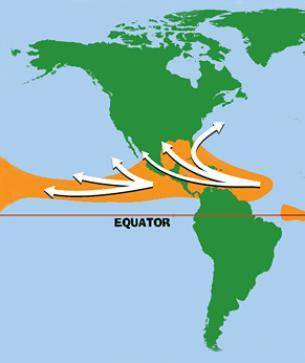
Biology, 10.05.2021 17:20 RebelZane18
On the map below, the white arrows represent likely paths of hurricanes.
Which of the following best describes what the orange area represents?
A. the region where the ocean water is deepest
B. the region where rapid evaporation occurs most
C. the region where evaporation occurs the slowest
D. the region where the ocean water is coldest


Answers: 3


Another question on Biology


Biology, 22.06.2019 01:30
Scenario 5 1) take 10 red and 10 black beans and place them, mixed, on the table. record the starting phenotype # and frequencies (% of your total population) of your starting population in the table provided (generation 0). 2) act as a predator. “capture” as many organisms as you can until you have reduced the population to three organisms. put them aside. at this point, the predators die. 3) the remaining organisms each produce 2 clonal offspring. multiply your organisms accordingly and allow them to mix on the table. calculate and record the resultant phenotype # and frequencies (% of your total population) of your population in the table provided (generation 1). 4) repeat the reproduction event, allowing each of your organisms to produce 2 clonal offspring. calculate and record the resultant phenotype # and frequencies (% of your total population) of your population in the table provided (generation 2). 5) repeat the reproduction event, allowing each of your organisms to produce 2 clonal offspring. calculate and record the resultant phenotype # and frequencies (% of your total population) of your population in the table provided (generation 3).
Answers: 1

Biology, 22.06.2019 01:30
Which is an advantage of having memory cells when a pathogen is encountered for a second time. a) the memory cells are what proliferate into clones of cells in response to the binding of an antigen. b) memory cells are vital to the primary immune response in that they immediately recognize pathogens even at the first encounter. c) memory cells are essentially effector cells that are short lived and attack antigens even without having a receptor specific to that antigen. d) it ensures that more lymphocytes with a receptor specific to a particular antigen will be present than in a host that had never encountered that pathogen.
Answers: 1

You know the right answer?
On the map below, the white arrows represent likely paths of hurricanes.
Which of the following b...
Questions

Computers and Technology, 24.08.2020 16:01


Health, 24.08.2020 16:01

English, 24.08.2020 16:01

Mathematics, 24.08.2020 16:01

Physics, 24.08.2020 16:01

Mathematics, 24.08.2020 16:01

Mathematics, 24.08.2020 16:01

Physics, 24.08.2020 16:01

Computers and Technology, 24.08.2020 16:01

Geography, 24.08.2020 16:01



French, 24.08.2020 16:01

Chemistry, 24.08.2020 16:01



History, 24.08.2020 16:01


Chemistry, 24.08.2020 16:01



